Swatch Group Bundle
Who Really Owns Swatch Group?
The Swatch Group, a titan of the watchmaking world, boasts a fascinating history intertwined with the 'quartz crisis' and a strategic vision to revitalize the Swiss watch industry. Understanding the Swatch Group SWOT Analysis is vital to grasping its market position. From its humble beginnings to its current status as a global powerhouse, the ownership structure of Swatch Group has played a pivotal role in its success.
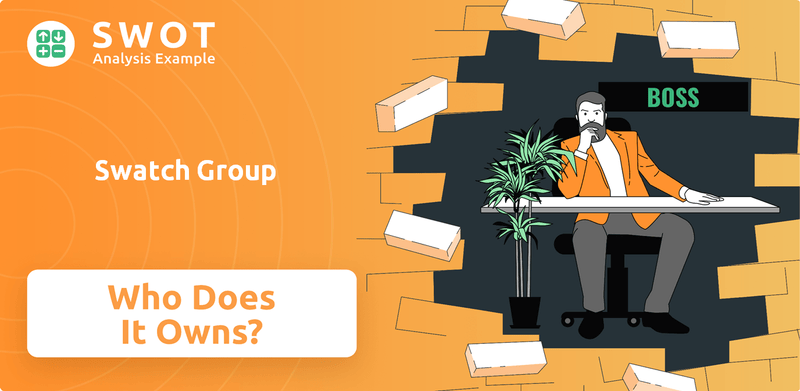
Delving into the Swatch ownership reveals a complex interplay of family influence, institutional investors, and public shareholders, each contributing to the company's strategic direction. Knowing who owns the Swatch watch company provides valuable insights into its decision-making processes, financial performance, and future prospects. This exploration will uncover the key players behind the Swatch brands and their impact on the company's legacy and continued evolution in the luxury watch market and beyond, including the Swatch Group subsidiaries.
Who Founded Swatch Group?
The genesis of the Swatch Group in 1983 was a direct response to the 'quartz crisis,' a period that significantly threatened the traditional Swiss watchmaking industry. This crisis, marked by the rise of cheaper, battery-powered quartz watches from Asia, nearly decimated the Swiss watch industry. The formation of the company was a strategic move to consolidate and revitalize the struggling Swiss watchmakers.
The Swatch Group emerged from the merger of two financially troubled Swiss watch companies, ASUAG and SSIH. While the specific equity split at the company's inception is not publicly detailed, the vision for the consolidated entity was largely driven by Nicolas G. Hayek. His leadership was pivotal in navigating the challenges and setting the stage for the company's future success.
Nicolas G. Hayek, a Lebanese entrepreneur and strategic consultant, was instrumental in orchestrating the merger and developing the group's future strategy. Hayek, along with a consortium of Swiss private investors, took a majority shareholding in the newly consolidated group, initially named SMH (Société Suisse de Microélectronique et d'Horlogerie). Hayek became Chairman of the Board of Directors and CEO in 1986. This strategic move allowed Hayek to implement his vision without immediate public market pressures.
The 'quartz crisis' of the 1970s and early 1980s, driven by the introduction of affordable quartz watches, nearly destroyed the Swiss watch industry. This led to the merger of ASUAG and SSIH, forming the foundation of the Swatch Group.
Nicolas G. Hayek played a crucial role in the formation and strategic direction of the Swatch Group. He orchestrated the merger and developed the innovative strategy that saved the Swiss watch industry.
Early investors, including Stephan Schmidheiny and Esther Grether, joined Hayek in taking majority ownership. This private ownership structure allowed for long-term strategic planning.
SMH, later renamed the Swatch Group, was transformed under Hayek's leadership. The focus shifted to affordable, fashionable watches under the 'Swatch' brand, revitalizing the company and the industry.
The move to private ownership provided the flexibility to implement long-term strategies. This shielded the company from the short-term pressures of public markets.
The Hayek family's continued involvement has been central to the company's management and strategic direction. Their influence ensures continuity and a long-term vision for the Swatch Group.
The Swatch Group's origins are deeply rooted in the strategic responses to the challenges posed by the quartz crisis. Nicolas G. Hayek's vision and leadership were critical in shaping the company's direction. The early ownership structure, with Hayek and a consortium of private investors, allowed for a focused, long-term strategy. The emphasis on the 'Swatch' brand and affordable, fashionable watches marked a significant shift in the industry. To learn more about the company's growth strategy, you can read about it in Growth Strategy of Swatch Group.
- Founding: The Swatch Group was formed in 1983 through the merger of ASUAG and SSIH.
- Leadership: Nicolas G. Hayek orchestrated the merger and became Chairman and CEO.
- Ownership: Hayek and private investors took majority ownership in 1985.
- Strategy: The focus shifted to affordable, fashionable watches under the 'Swatch' brand.
Swatch Group SWOT Analysis
- Complete SWOT Breakdown
- Fully Customizable
- Editable in Excel & Word
- Professional Formatting
- Investor-Ready Format
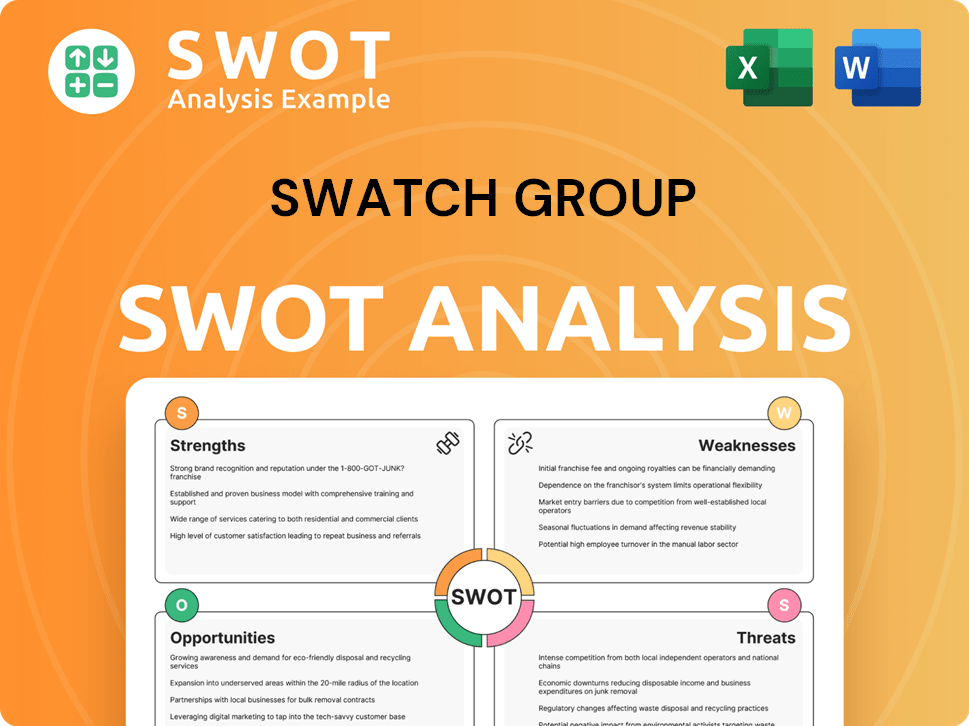
How Has Swatch Group’s Ownership Changed Over Time?
The evolution of Swatch Group's ownership reflects a strategic shift from private to public ownership. Initially, the company, then known as SMH, was taken private in 1985 by Nicolas Hayek and a consortium of Swiss investors. This marked the beginning of a significant transformation. Later, in 1998, the company was renamed The Swatch Group Ltd., and it was subsequently listed on the SIX Swiss Exchange under the ticker symbol UHR, opening it up to public investment while maintaining strong family control.
The dual-share structure of Swatch Group allows the Hayek family to retain considerable influence. As of May 2025, the Hayek family held approximately 44% of the voting rights, even though their capital ownership was around 25%. This structure has been crucial in ensuring the family's long-term vision for the company, influencing its strategic direction and governance over the years. This has allowed the company to balance public ownership with the benefits of family leadership.
| Ownership Milestone | Year | Details |
|---|---|---|
| Private Ownership | 1985 | Nicolas Hayek and Swiss investors take SMH private. |
| Company Renamed | 1998 | SMH becomes The Swatch Group Ltd. |
| Public Listing | 1998 | The Swatch Group Ltd. lists on the SIX Swiss Exchange. |
As of early 2025, the major institutional shareholders included UBS Asset Management (Switzerland) with 1.50% ownership as of April 30, 2024, Harris Associates L.P. with 1.10% as of December 31, 2024, and The Vanguard Group, Inc. with 0.63% as of January 31, 2025. Other significant institutional investors include BlackRock Financial Management, Inc., Norges Bank Investment Management (NBIM), and UBS Fund Management (Switzerland) AG. These holdings, while substantial, are secondary to the Hayek family's control. The Hayek family's continued influence ensures a focus on long-term strategic goals.
The Swatch Group's ownership structure is a blend of family control and public investment.
- The Hayek family holds a significant portion of voting rights.
- Institutional investors hold smaller stakes.
- This structure impacts the company's long-term strategy.
- The company's dual-share structure allows for family control.
Swatch Group PESTLE Analysis
- Covers All 6 PESTLE Categories
- No Research Needed – Save Hours of Work
- Built by Experts, Trusted by Consultants
- Instant Download, Ready to Use
- 100% Editable, Fully Customizable
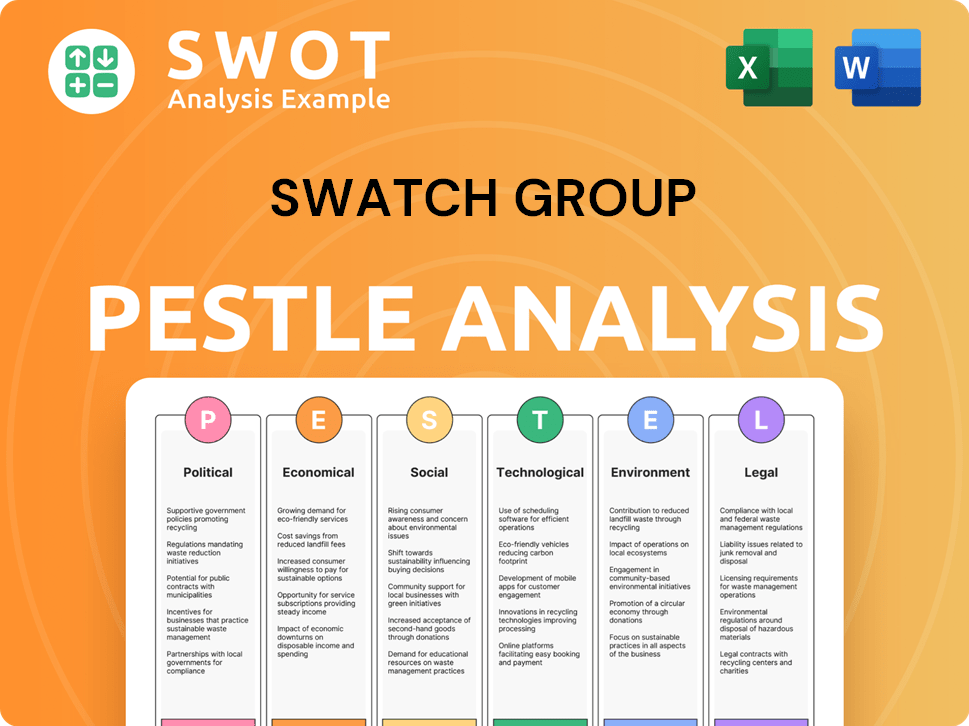
Who Sits on Swatch Group’s Board?
The current board of directors of The Swatch Group, which significantly influences the company's ownership structure, includes key figures from the Hayek family. Nayla Hayek serves as the Chair, while her brother, Nick Hayek Jr., holds the position of Chief Executive Officer. Their roles highlight the Hayek family's substantial stake and strategic influence over the company's direction. The Hayek family's presence on the board is crucial in shaping the future of the company, including decisions about Swatch brands and Swatch Group subsidiaries.
The company's structure, with its dual-class shares, gives the Hayek family significant voting power relative to their capital ownership. As of May 2025, the Hayek family holds approximately 25% of the shares but controls just under 43% to 44% of the voting rights. This arrangement ensures the founding family retains considerable control over decision-making, even though other investors own a larger portion of the share capital. Understanding Swatch ownership is key to grasping the company's governance dynamics.
| Board Member | Position | Key Role |
|---|---|---|
| Nayla Hayek | Chair | Oversees strategic direction and governance. |
| Nick Hayek Jr. | CEO | Manages day-to-day operations and strategic initiatives. |
| Other Board Members | Various | Provide expertise and oversight across different areas. |
In May 2025, an activist investor, Steven Wood, from GreenWood Investors, attempted to secure a board seat, representing bearer shareholders. Wood advocated for greater representation and a stronger focus on luxury brands. However, his bid was rejected by a large majority of shareholders, with 79.2% voting against his election. Proxy advisory firms, including Institutional Shareholder Services (ISS) and Glass Lewis, recommended against the re-election of certain supervisory board members, including Nayla Hayek and Nick Hayek, due to concerns over board independence and executive pay transparency. This outcome emphasizes the Hayek family's strong control over the company's governance and their ability to fend off attempts by activist investors to change the board's composition. For more insights into the company's financial operations, you can explore Revenue Streams & Business Model of Swatch Group.
The Hayek family maintains significant control through a dual-class share structure.
- The Hayek family holds approximately 25% of the shares but controls nearly 43% to 44% of the voting rights.
- Activist investor attempts to influence the board have been unsuccessful.
- Proxy advisory firms have raised concerns about board independence.
- The board's composition reflects the ongoing influence of the founding family.
Swatch Group Business Model Canvas
- Complete 9-Block Business Model Canvas
- Effortlessly Communicate Your Business Strategy
- Investor-Ready BMC Format
- 100% Editable and Customizable
- Clear and Structured Layout
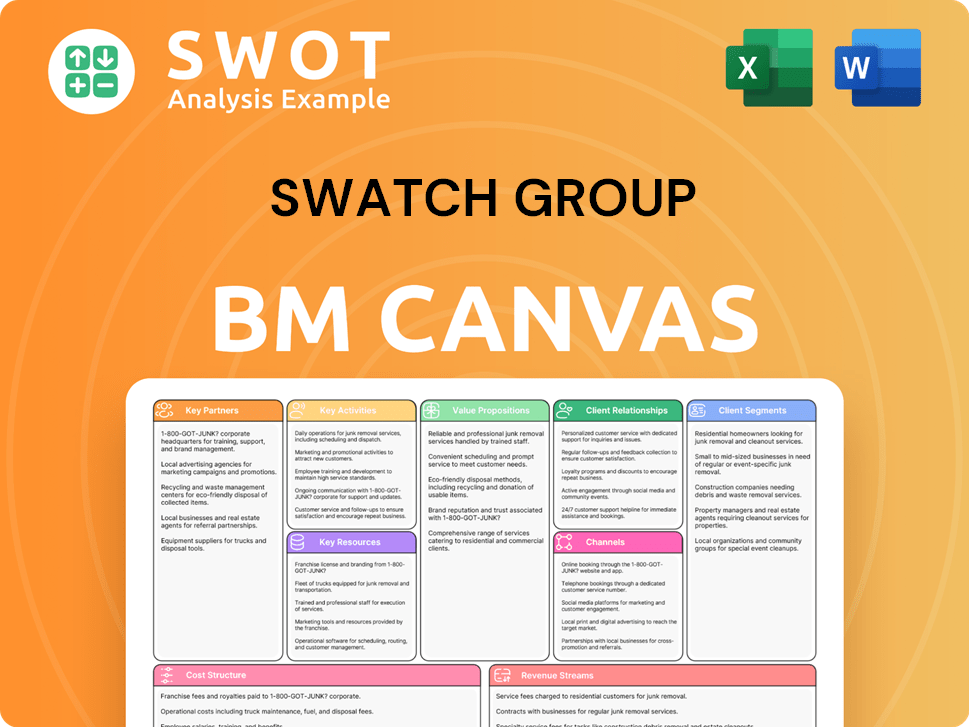
What Recent Changes Have Shaped Swatch Group’s Ownership Landscape?
Over the past few years, the Swatch Group has faced notable market challenges. The company's 2024 financial results reflect this, with a 12.2% decrease in net sales at constant exchange rates, totaling CHF 6,735 million. Net income saw a significant drop, plummeting by 75% to CHF 219 million from CHF 890 million in 2023. However, the company experienced record sales and market share gains in the USA, Japan, India, and the Middle East during 2024, particularly with brands like Omega, Longines, and Tissot. The Growth Strategy of Swatch Group provides further insights into the company's approach.
The Hayek family maintains a dominant position in the Swatch watch company, controlling around 44% of the voting rights. This was evident in the May 2025 proxy battle where a U.S. investor's attempt to gain a board seat to shift the focus towards luxury brands was rejected by shareholders. This outcome underscores the family's commitment to their long-term strategy and their resistance to external pressures. The Swatch Group ownership structure, with the Hayek family at its core, continues to shape the company's direction and strategic decisions, even as the stock price has declined since late 2013.
| Financial Metric | 2023 | 2024 |
|---|---|---|
| Net Sales (CHF million) | 7,670 | 6,735 |
| Net Income (CHF million) | 890 | 219 |
| Sales Decline (Constant Exchange Rates) | - | 12.2% |
Industry trends reveal a mixed landscape. While some luxury competitors have seen growth, the watch division for many, including Swatch Group, has faced headwinds. The 'very high end' of the watch market is the only segment consistently showing growth. Despite expected continued subdued demand in China, the Swatch Group anticipates improved sales, operating results, and cash flow in 2025, driven by new model launches and positive global momentum. Discussions have arisen regarding the possibility of Swatch Group going private, though the Hayek family has expressed no interest in taking on debt for such a move.
The Swatch Group was founded by Nicolas Hayek, who is also a key figure in the company's history and strategy.
The current CEO is not mentioned in the provided context. However, the Hayek family's influence is central to the company's direction.
The Swatch Group has a diverse portfolio, including Omega, Longines, Tissot, and Swatch among many others.
While specific market share figures fluctuate, the Swatch Group is a significant player in the global watch market, particularly in the mid-range and luxury segments.
Swatch Group Porter's Five Forces Analysis
- Covers All 5 Competitive Forces in Detail
- Structured for Consultants, Students, and Founders
- 100% Editable in Microsoft Word & Excel
- Instant Digital Download – Use Immediately
- Compatible with Mac & PC – Fully Unlocked
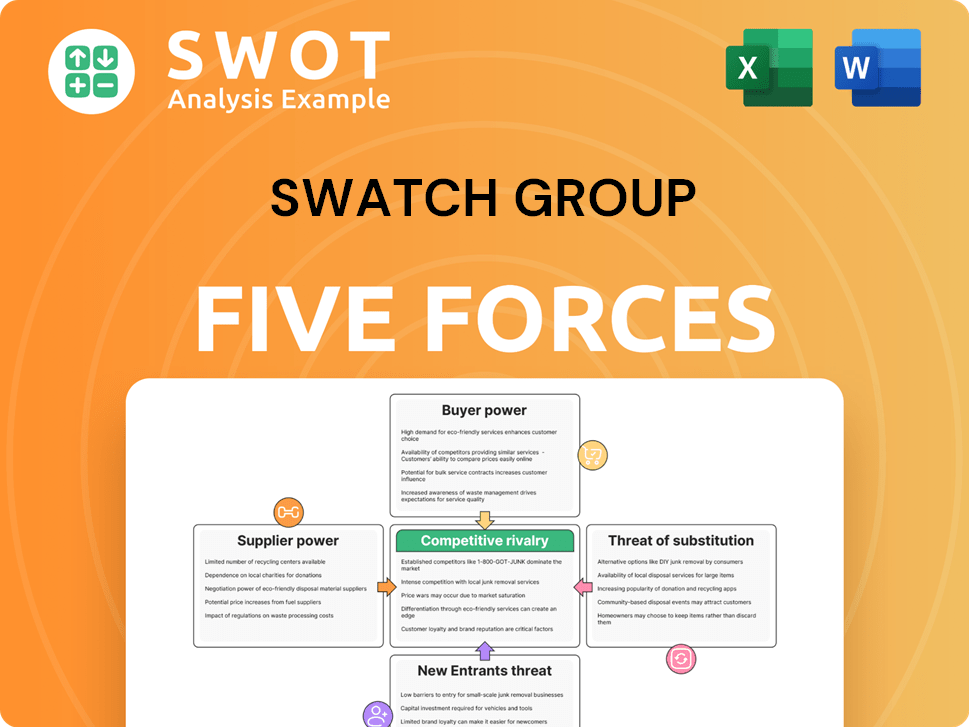
Related Blogs
- What are Mission Vision & Core Values of Swatch Group Company?
- What is Competitive Landscape of Swatch Group Company?
- What is Growth Strategy and Future Prospects of Swatch Group Company?
- How Does Swatch Group Company Work?
- What is Sales and Marketing Strategy of Swatch Group Company?
- What is Brief History of Swatch Group Company?
- What is Customer Demographics and Target Market of Swatch Group Company?
Disclaimer
All information, articles, and product details provided on this website are for general informational and educational purposes only. We do not claim any ownership over, nor do we intend to infringe upon, any trademarks, copyrights, logos, brand names, or other intellectual property mentioned or depicted on this site. Such intellectual property remains the property of its respective owners, and any references here are made solely for identification or informational purposes, without implying any affiliation, endorsement, or partnership.
We make no representations or warranties, express or implied, regarding the accuracy, completeness, or suitability of any content or products presented. Nothing on this website should be construed as legal, tax, investment, financial, medical, or other professional advice. In addition, no part of this site—including articles or product references—constitutes a solicitation, recommendation, endorsement, advertisement, or offer to buy or sell any securities, franchises, or other financial instruments, particularly in jurisdictions where such activity would be unlawful.
All content is of a general nature and may not address the specific circumstances of any individual or entity. It is not a substitute for professional advice or services. Any actions you take based on the information provided here are strictly at your own risk. You accept full responsibility for any decisions or outcomes arising from your use of this website and agree to release us from any liability in connection with your use of, or reliance upon, the content or products found herein.